It is raining and we are on our sixth day in Paris. We just returned from the Bastille Sunday market where we picked up some potatoes, carrots, and a bottle of wine. These will go with some shrimp, zucchini, tomatoes, and a lemon for a lovely dinner later this evening. We feel blessed that this is only the fourth day of our six-week journey that has been impacted at all by rain.
There is so much to see and do in Paris that it’s taken me this long to find some time to write about it.
We rented a studio apartment in the Marais for a week. Steps from our apartment is Place du Marche Ste. Catherine, the cutest little square, with six cafes.

Our Courtyard and View 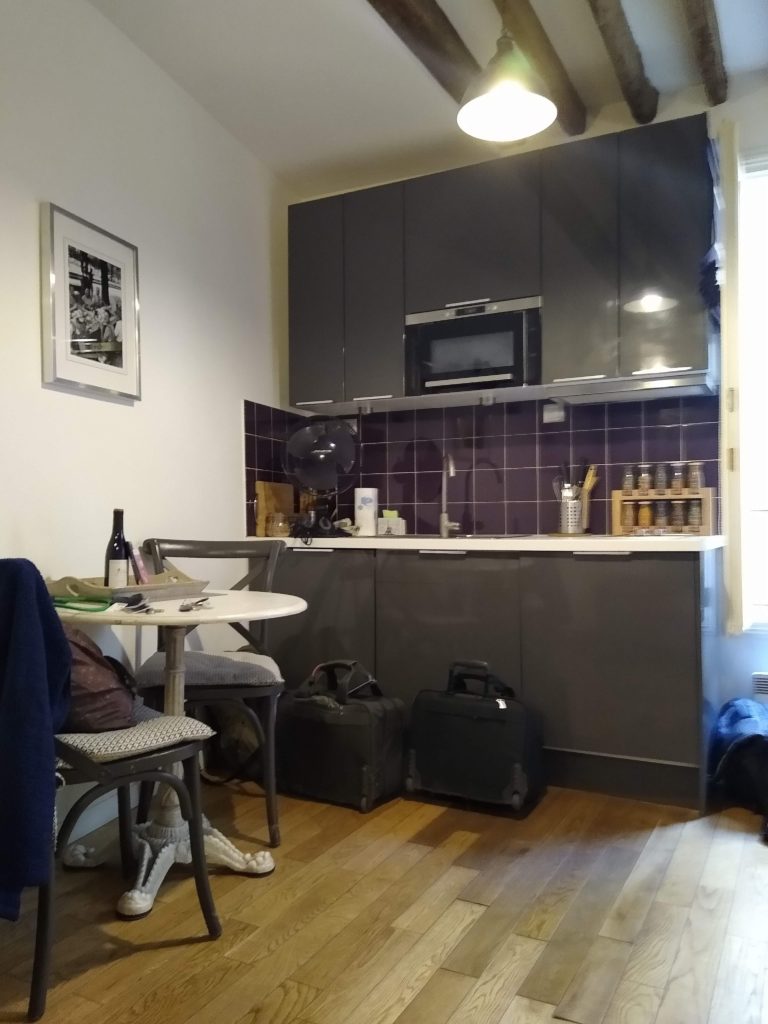
Our Little Kitchen 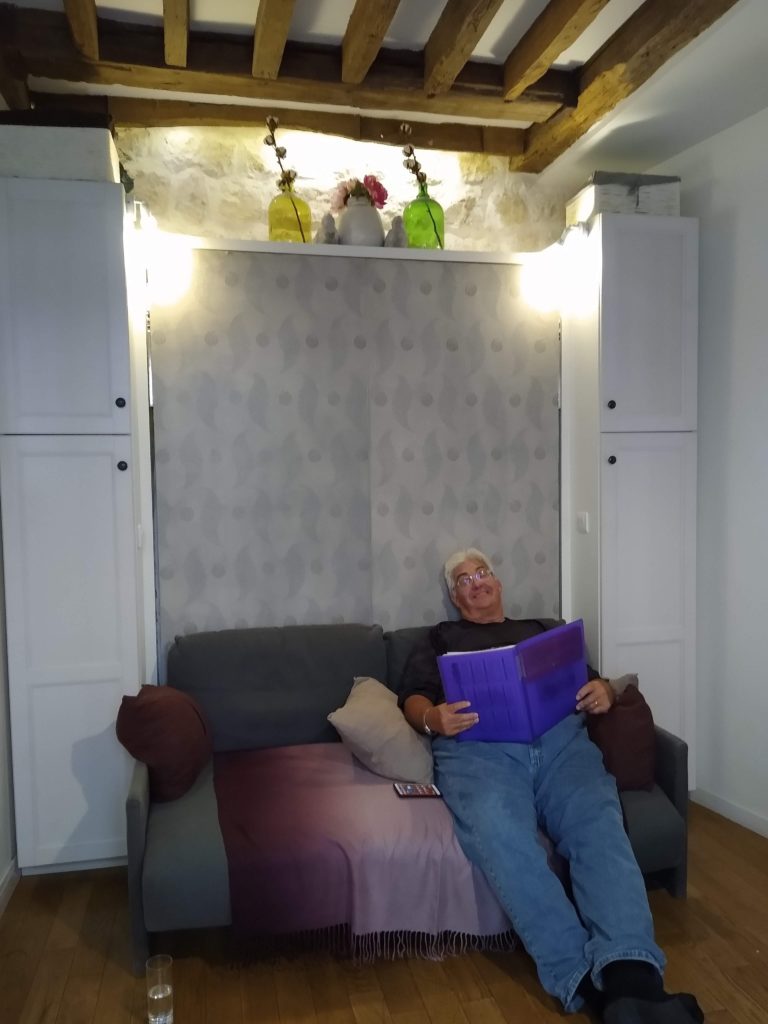
Dave in Front of the Murphy Bed 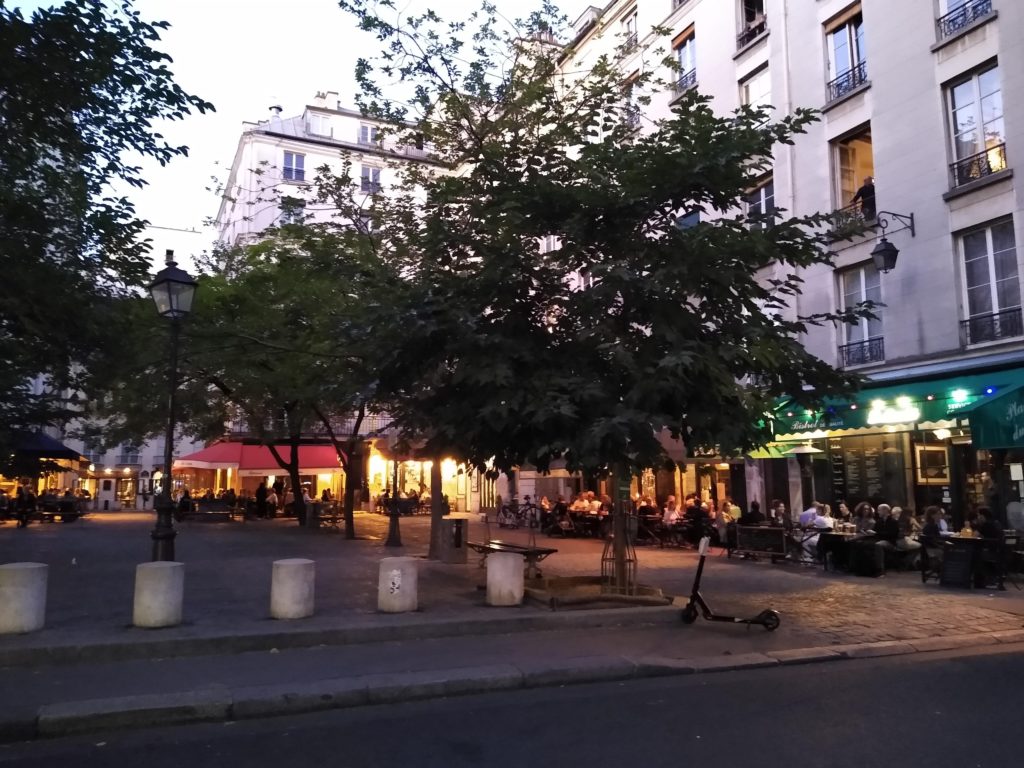
Place du Marche Ste. Catherine (and 4 of the 6 cafes)
Within a block we have two bakeries, two wine shops, a cheese shop, a chocolate shop, a meat market, a fish market, a produce shop, and a grocery store. We have had fun, practicing our French in the shops. Breakfast has been a steady diet of pain au chocolate with strawberries and coffee … yum! We cooked dinner in once and have had cheese and crackers with wine and beer for lunch. We feel like Parisians who don’t speak the language! But we must be getting points for trying as all the shopkeepers have been very nice.
We would highly recommend this type of accommodation if you are staying in Paris for more than a few days (which you will want to do because there is so much here). Though $175 a night seems expensive, the rule of thumb is well over $200 for a hotel if you stay in the core (basically anywhere bordering the Seine). Plus, you get the added bonus of being able to eat in and enjoy the daily round of shops to do so, thus saving money.
Eating in Paris
Since we spent a lot on the apartment, we wanted to keep our food budget at a more reasonable level. It’s surprisingly easy to do in Paris.
Cafes
Cafes are a way of life here. Their interiors are small so they increase their footprint by spilling out onto the sidewalk. This also allows smokers somewhere to eat as smoking indoors is outlawed in France. There are umbrellas and heaters so people sit outside to eat in weather much colder than you might expect.
Usually there is a board with daily specials, ‘Plats du jour’. Most also have a pre fixe option where for one price you get three courses (starter, main course, and dessert) with select options for each. If you are really hungry, these are usually a good deal, running from €18-30.
Wine is inexpensive compared to the U.S. at about €4-6 per glass for house wine but I’ve never been disappointed. Beer is more expensive at about €7 per glass. If you want water you must specify tap water if you want it for free (and some don’t give you that option). Otherwise, you pay as much for water (and soda) as you do for beer.
They don’t look to turn tables here like they do in the U.S. so you can linger, nursing a glass of wine or coffee for as long as you like. It’s fun to relax and watch the world go by.
Eating in and Picnics
Because we had a kitchen, we were able to cook and eat in several times. As mentioned earlier, we had a lot of fun in the specialty shops and markets, practicing our French and buying what we wanted. Everything is fresh and most of it is local. Wine is a deal here with good bottles going for €5-8. We put together our shrimp dinner with potatoes, carrots, zucchini, and tomatoes with a bottle of wine for about $18.
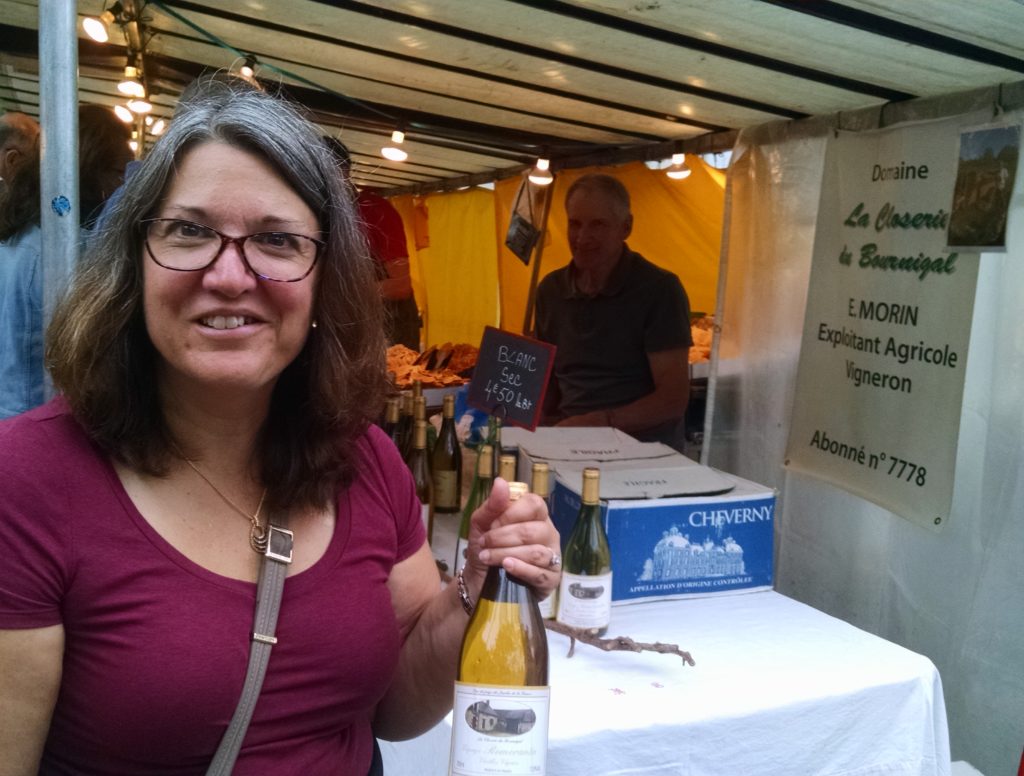
Buying Wine From the Grower 
Shopping at Bastille Market
If you don’t have a kitchen, you can still enjoy this experience but limit your shopping to picnic items. All you need is bread, cheese, some lunch meat, maybe some fruit and a bottle of wine and away you go. Lots of people picnic along the Seine every night.
You will also find creperie stands, bars on boats along the Seine, and fine dining restaurants (which we rarely frequent). In our neighborhood, there is a pizza restaurant, Cafe American, and a Scottish pub. Food options run the gamut. You won’t go hungry and you don’t have to go broke.
Getting Around Paris
It is actually pretty easy to get around Paris, once you know the ropes. We have learned the tricks of the metro, the RER, the Batobus, and taxis.
Batobus
The Batobus is basically a bus on the Seine. There are nine stops, three on the right bank – Hotel del Ville (our stop), the Louvre, and Place de la Concorde. There are six on the left bank – Eiffel Tower, Invalides Pont, Musee D’Orsay, Saint-Germain, Notre Dame, and Jardin des Plantes. You get either a 24 or 48-hour pass that starts at your time of purchase. We bought the 48-hour pass at 11:15 am on Wednesday and rode the Batobus until 11:15 Friday morning. You can hop on and off at will. The only issue is that the Batobus stops running at 7:00 pm (9pm before September 1). It was a great way to get our bearings and see some things while enjoying the river.
The Metro
Our introduction to the Metro did not go well. We arrived at the Paris Nord station on the Thalys high speed train from Brussels with our luggage in tow. To get to our apartment, we needed to catch Metro line 5 to the Bastille stop and walk about ten minutes from there. Sounded simple. And, to start with, it was. We found the Metro line easily enough. We had a little trouble with the ticket machine so went to the ticket office. We found the right platform and got on the right train and got off at the right stop. So far, so good. Up to now, the only issue was the lack of escalators.
The Bastille stop connects several Metro lines so there are tunnels and stairways going multiple directions. Plus, there are several actual exits depending on which direction you want to go once you are out of the station. We didn’t know where we needed to go and all the signs were in French. Finally, we chose to go up the stairs to where we saw daylight assuming it was an exit. It wasn’t, just a street-level Metro line. A nice French lady noticed our confusion (and probably frustration) and was able to give us directions. It was sunny and warm so we were feeling pretty beat by the time we arrived to our final destination.
As a result, we were wary of using the Metro which led to one very long walk and fairly expensive taxi ride on the day we went to Musee D’Orsay (story to be covered in another post).
The tricks to the metro are really pretty simple once you catch on.
- Know which Metro line or lines you need. There are many and they intersect each other in various places. A good Metro map is essential.
- Know the end points of each Metro line you will use (found on the Metro map, just follow your line to its end points). Signs in the station will tell you the end point. You use different stairways or tunnels depending on which way you are going so if you want the right platform, you need to know where it will end up.
- Every train makes every stop so any train that stops at your platform is the right train.
- It costs €1.90 for a one-hour ticket so you can ride as many trains as you need to get to your destination on one ticket.
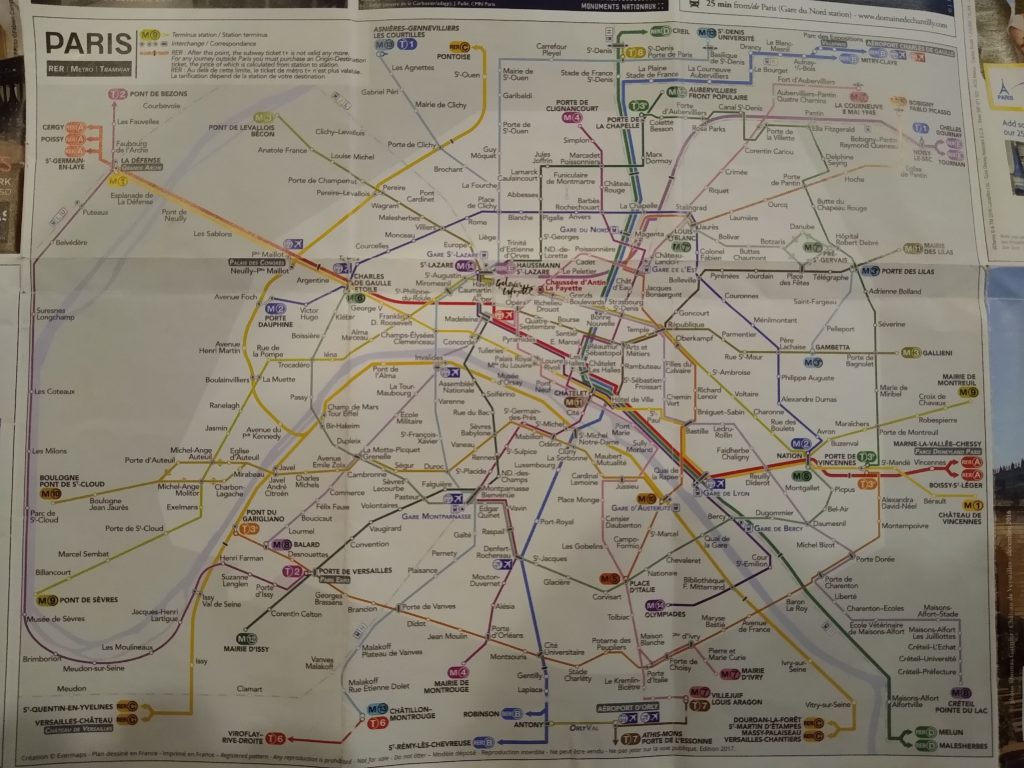
Once we figured all this out, we used the Metro several times without any problems.
The Suburban Trains (RER)

The Metro gets you all over Paris but if you want to daytrip outside the city, you need the RER. These connections can only be made at several stations. Googlemaps will provide public transportation routes to help you. We went to Versailles by train and had an interesting time with it due to the protests on Saturday.
Our route to Versailles was to walk to the Bastille station, catch the metro 5 line towards Place d’Italie (the end point) to Gare d’Austerlitz where we would catch the RER ‘C’ train to Versailles.
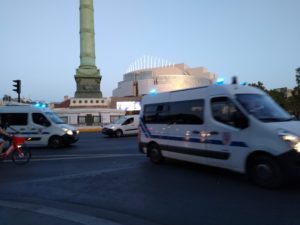
When we got to Gare d’Austerlitz, we were looking for the C train platform. Dave asked a Metro employee for directions and we were told to go out of the station and catch metro line 10. This didn’t make sense but we followed her directions. Somebody noticed our confusion and volunteered the information that the C trains weren’t running all the way to Gare d’Austerlitz because of police actions with the protesters. So we had to take the metro 10 line to the Javel stop and catch a C train there. We had to take this route back as well.
In fact, when we finally got off the train at Bastille station, a caravan of police cars and motorcycles plus a few fire trucks, sirens blaring, came cruising by. Several stopped and we could see that the police had on riot gear. Lessons learned:
- You need to be flexible because you never know when your journey may be disrupted by a strike or a protest.
- The French people are really very nice and will help you if you are lost or confused (even if you don’t speak French).
Taxis
Traffic in Paris is terrible so public transportation is the preferred way around town. But, if you do want a taxi, there are a few things you need to know.

- Legal taxis have a sign on top of their vehicle that will have the name of their company and either a green or red light. Green means they are available, red means they are not.
- You can hail a taxi but they are not always easy to find.
- The easier way to get a cab is to find a taxi stand. They are never too far away and are marked on good city maps. In our experience, Googlemaps did not always find the nearest one.
- If you call and reserve a taxi, you will pay a €7 reservation fee plus a €4+ pick up fee.
We used taxis twice. First, after a long walk from Musee D’Orsay to the Eiffel Tower late at night. In this case, we knew where there was a taxi stand but were able to hail a cab before we got there. Second was to get us to the airport.
After the trouble lugging our bags on arrival, we wanted to use the recommended shuttle service. But we had trouble with the online form and by the time we gave up on that and called, they had no availability. So we toted our luggage to the taxi stand a couple blocks away, grabbed the taxi that was there, and away we went. If your luggage is manageable, I would recommend this as you save over €11 in extra fees.
My next post on paris will cover some of her iconic landmarks that we visited. http://europeyourway.net/eiffel-tower

